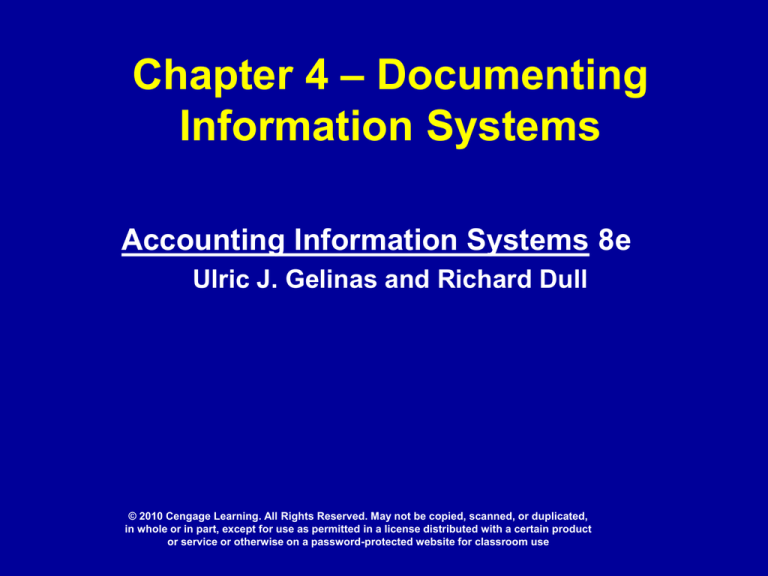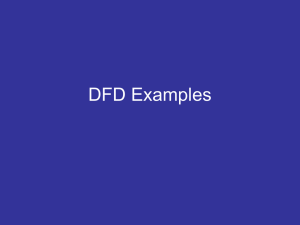
Chapter 4 – Documenting
Information Systems
Accounting Information Systems 8e
Ulric J. Gelinas and Richard Dull
© 2010 Cengage Learning. All Rights Reserved. May not be copied, scanned, or duplicated,
in whole or in part, except for use as permitted in a license distributed with a certain product
or service or otherwise on a password-protected website for classroom use
Learning Objectives
• Read and evaluate data flow diagrams.
• Read and evaluate systems flowcharts.
• Prepare data flow diagrams from a narrative.
• Prepare systems flowcharts from a narrative.
2
Documentation Process
• Process documentation is a important skill in
accounting.
• Data flow diagrams portray a business
processes’ activities, stores of data, and flows
of data among those elements.
• System flowcharts present a comprehensive
picture of the management, operations,
information systems, and process controls
embodied in business processes.
3
Basic DFD Symbols
4
Context Diagram
5
Physical DFD
• Graphical representation of a system showing
the system’s internal and external entities, and
the flows of data into and out of these entities.
• Specifies where, how, and by whom a system’s
processes are accomplished.
• Does not specify what is being accomplished.
• In the following slide, we see where the cash
goes and how the cash receipts data are
captured but not exactly what was done by the
sales clerk.
6
Physical DFD
7
Logical DFD
• Graphical representation of a system showing the
system’s processes (as bubbles), data stores, and
the flows of data into and out of the processes and
data stores.
• Used to document information systems —what tasks
the system is doing— without having to specify how,
where, or by whom the tasks are accomplished.
• Concentrates on the functions that a system
performs.
• A logical DFD portrays a system’s activities, whereas
a physical DFD depicts a system’s infrastructure.
• Both are needed to completely understand a system.
8
Logical
DFD
9
Balanced DFDs
• Exist when the external data flows are
equivalent.
• On the following slide, DFD (a) is
a context diagram and (b) is an
“explosion” of it into a level 0
logical DFD. DFD (c), (d) and (e)
are “explosions” of the logical level
0 DFD, etc.
10
Balanced
DFDs
11
Standard
Flowchart
Symbols
12
Common System Flowcharting
Routines
• The following slides show several
common ways of showing
processing using system
flowcharting.
• Note the way the columns are set up
to communicate the flow of activities
between processing entities.
13
Enter document
into computer via
keyboard, edit
input, record
input.
14
User queries
the computer.
Update
sequential
data store.
15
Preparation
and manual
reconciliation
of control
totals.
16
Key and
key verify
inputs.
17
Enter
document
into
computer
using a
scanner.
18
Enter document into computer using scanner & manual keying.
19
Preparing Data Flow Diagrams
• Read narrative carefully - number
lines and paragraphs in text.
• Prepare table of entities and
activities.
• Draw context diagram - use DFD
guidelines.
20
21
DFD Guidelines
1. Include within the system context (bubble) any entity
that performs one or more information processing
activities.
2. For now, include only normal processing routines, not
exception routines or error routines, on context
diagrams, physical DFDs, and logical level 0 DFDs.
3. Include on the systems documentation all (and only)
activities and entities described in the systems narrative.
4. When multiple entities operate identically, depict only
one to represent all.
22
Causeway Context Diagram
23
DFD Guidelines (cont’d.)
5. For clarity, draw a data flow for each flow
into and out of a data store. You may label
each flow with the activity number that gives
rise to the flow or with a description of it.
6. If a data store is logically necessary
(because of a delay between processes),
include a data store in the diagrams,
whether or not it is mentioned in the
narrative.
24
Causeway Current Physical DFD
25
DFD Guidelines (cont’d.)
7. Group activities if they occur in the same
place and at the same time.
8. Group activities if they occur at the same
time but in different places.
9. Group activities that seem to be logically
related.
10.To make the DFD readable, use between
five and seven bubbles.
26
27
Causeway
Current
Logical
DFD
(Level 0)
28
DFD Guidelines (cont’d.)
11. A data flow should go to an operations entity square
only when operations process functions such as storing
goods, picking goods, packing orders and so on are to
performed by that entity.
12. A data flow should enter an entity bubble if the
operations process entity is to perform an information
processing activity.
13. On a physical DFD, reading computer data stores and
writing to computer data stores must go through a
computer bubble.
14. On a logical DFD, data flows cannot go from higher- to
lower-numbered bubbles.
29
Preparing Systems Flowcharts
1. Divide the flowchart into columns; one column
for each internal entity and one for each
external entity. Label each column.
2. Flowchart columns should be laid out so that
the flowchart activities flow from left to right.
Minimize crossed lines and connectors.
3. Flowchart logic should flow from top to bottom
and from left to right. For clarity, put arrows
on all flow lines.
30
Preparing Systems Flowcharts
(cont’d.)
4. Keep the flowchart on one page, if possible.
With multiple pages use off-page connectors.
5. When using a computerized flowcharting
package, your flowcharts will only print on paper
that fits in your printer.
6. Within each column, there must be at least one
manual process, keying operation, or data store
between documents. Do not directly connect
documents within the same column.
31
Causeway’s Systems Flowchart
• The systems flowchart for
Causeway follows on the next slide.
• This flowchart is without an
enterprise database.
32
Causeway’s Systems Flowchart
33
Preparing Systems Flowcharts
(cont’d.)
7. When crossing organizational lines (one
column to another), show a document at both
ends of the flow line unless the connection is so
short that the intent is unambiguous.
8. Documents or reports printed by a centralized
computer facility on equipment located in
another organizational unit should not be shown
within the computer facility.
34
Preparing Systems Flowcharts
(cont’d.)
9. Processing within an organizational unit on
devices such as a PC or computerized cash
register should be shown within the unit or as a
separate column next to that unit, but not in the
central computer facility column.
10. Sequential processing steps (computerized or
manual) with no delay between them (and
resulting from the same input) can be shown as
one process or as a sequence of processes.
35
Preparing Systems Flowcharts
(cont.)
11.The only way into a computer data storage
unit is through a computer processing
rectangle.
12.A manual process is not needed to show
the sending of a document.
13.Do not use a manual process to file a
document. Show the document going into a
file.
36
Causeway’s Systems Flowchart
• The systems flowchart for
Causeway is presented again on
the next slide.
• This flowchart is again presented
without an enterprise database.
37
Causeway’s Systems Flowchart
38
Documenting Enterprise Systems
• Moving from a file-based system to an
enterprise database changes the
system flowchart.
– An enterprise database replaces
transaction and master data.
– Other flows may change depending on the
system implementation.
39
Causeway’s Systems Flowchart
• The systems flowchart for
Causeway follows on the next slide.
• This flowchart is with an enterprise
database.
40
Causeway’s Systems Flowchart
41





